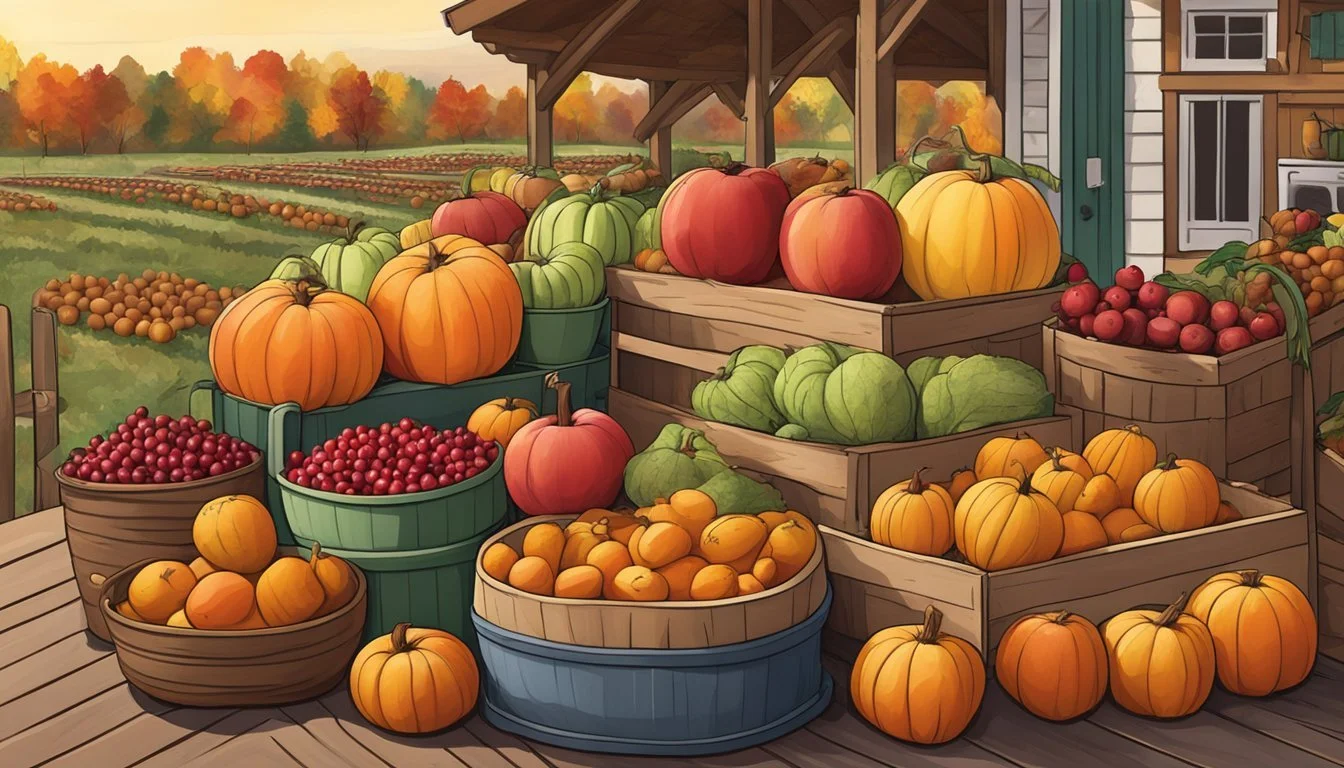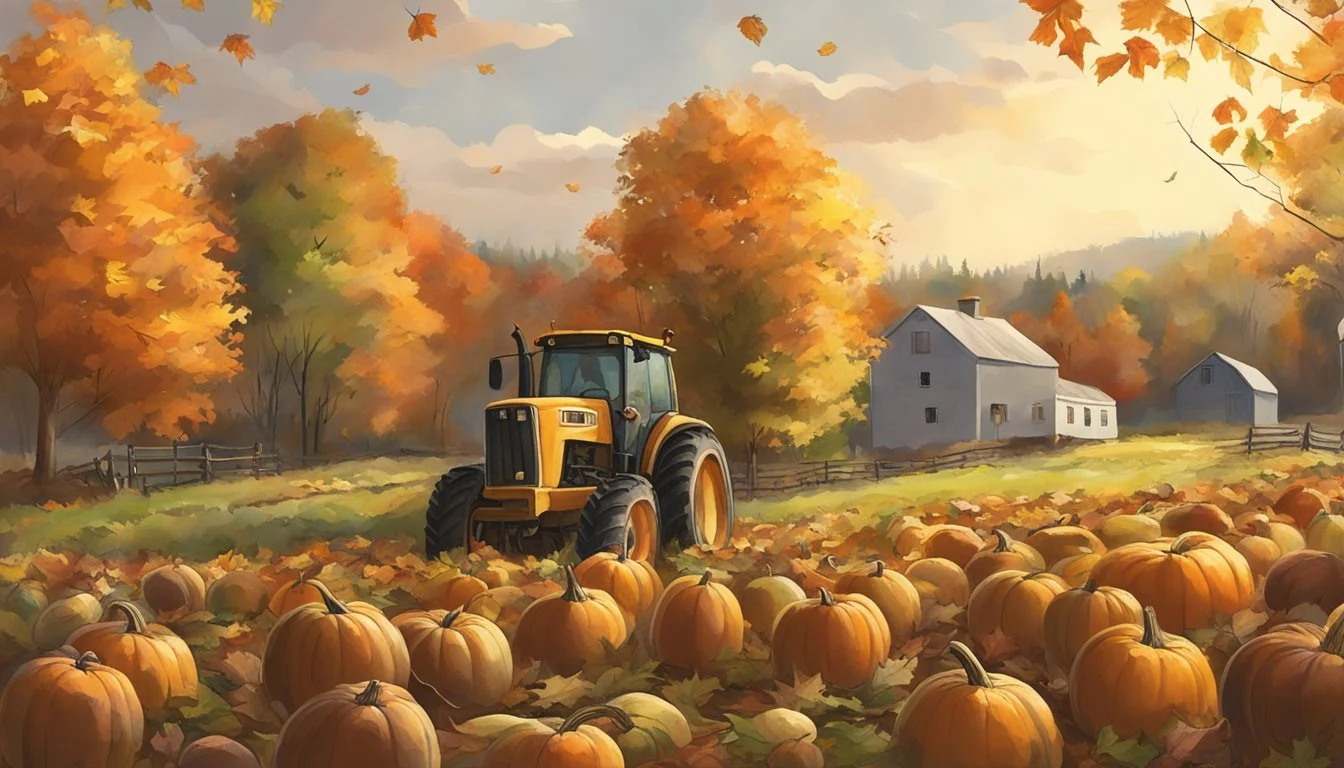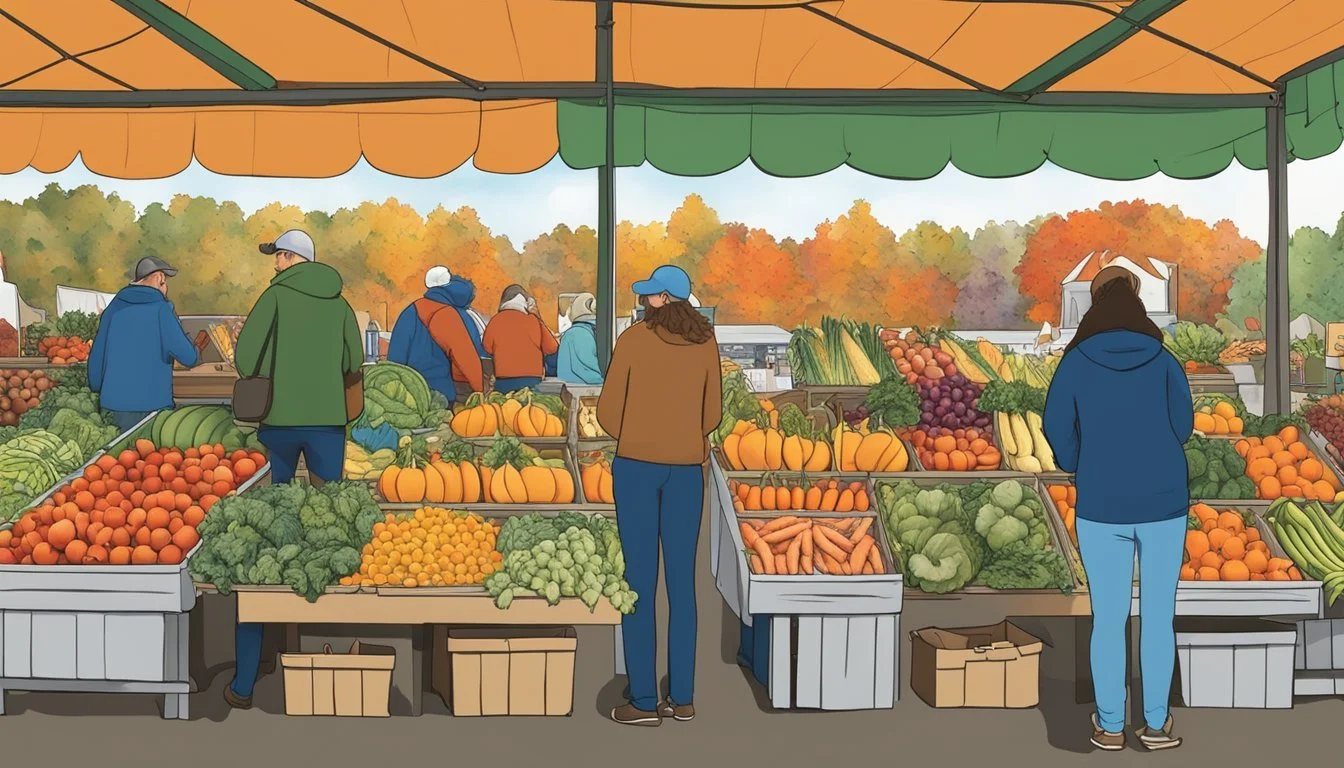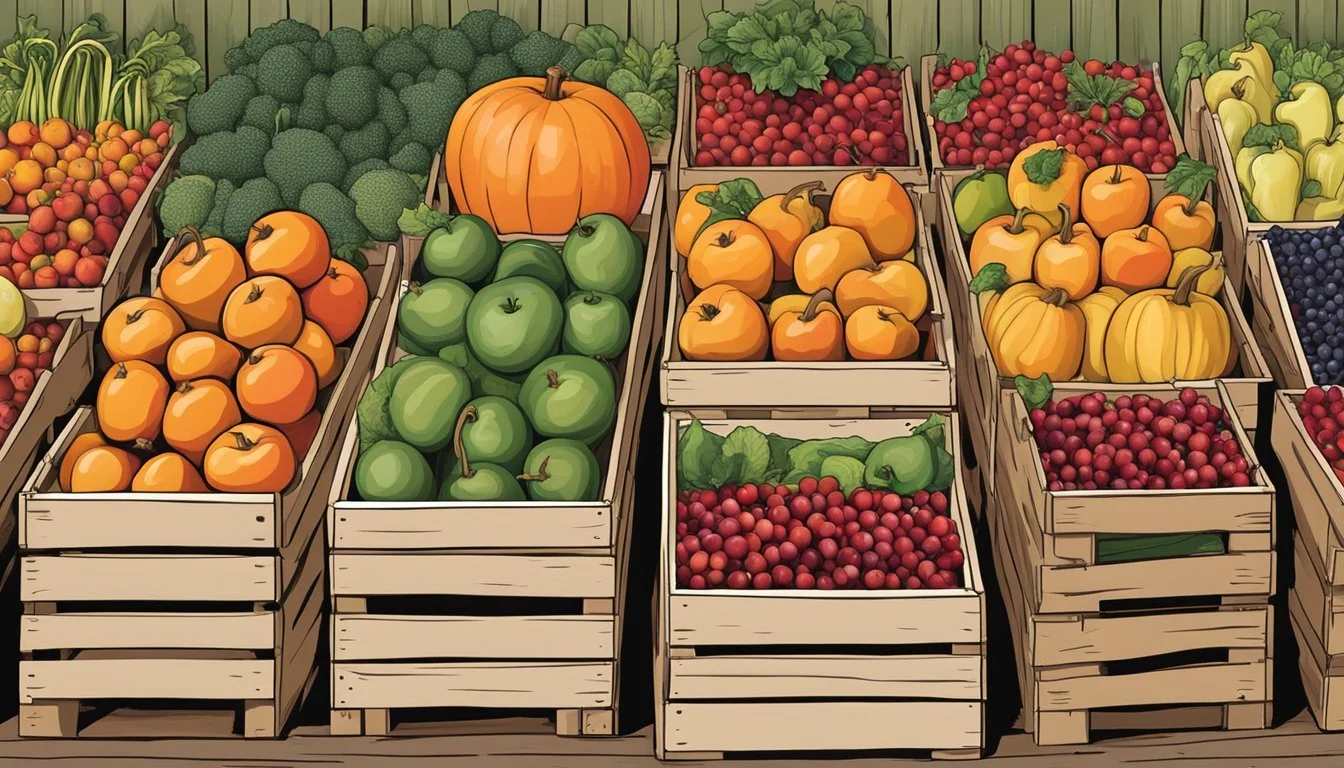Maine Seasonal Fruit & Vegetables in November
Your Guide to Local Produce
This Article is Part of our Maine Seasonal Fruit & Veg Calendar
() ()As the brisk autumn days of November sweep through Maine, local produce offers a hearty selection of fruits and vegetables that can withstand the cooler temperatures. Farmers across the state, renowned for their resilience and innovation, harvest the late-season crops that Maine's unique climate can support. The landscape of available produce during this month is characterized by storage crops such as apples (how long do apples last?) and root vegetables, which remain staples in the diet of Mainers throughout the winter months.
In this season, Mainers take advantage of the remaining fresh harvest that includes items such as brussels sprouts (how long do brussels sprouts last?), cabbage, and winter squash—crops that not only survive but thrive in the descending temperatures. Root vegetables like carrots (how long do carrots last?), beets (how long do beets last?), and parsnips, having developed their full flavor, become central to the local cuisine, often appearing in stews, roasts, and traditional Thanksgiving dishes.
The emphasis on seasonal eating is more than a culinary preference; it is a sustainable practice that supports Maine's agricultural community and reduces food miles. While the selection of produce may narrow as the cold takes hold, the quality and nutritional value of November's offerings remain high, ensuring that local markets continue to provide for the communities they serve well into the onset of winter.
Understanding Seasonality in Maine
In Maine, the concept of seasonality is crucial for both growers and consumers. As November ushers in the colder weather, the agricultural focus shifts predominantly to hardy vegetables and stored harvest from earlier months. Local availability means that individuals have access to produce that has not travelled long distances, supporting the Maine economy and reducing carbon footprints.
Seasonal produce during this time includes a variety of root vegetables and hearty greens that can withstand the first frosts. Farmers in Maine have adapted to the climate by extending the growth season of some vegetables using techniques like mulching and greenhouse cultivation.
A list of available produce in November typically includes:
Root Vegetables:
Beets
Carrots
Parsnips
Potatoes (What wine goes well with potatoes?)
Rutabaga
Turnips
Alliums:
Garlic
Onions
Leeks
Leafy Greens:
Kale
Spinach
Collards
Preserved goods from earlier harvests, such as apples and dry beans, also remain available. Maine's cold storage capabilities allow for continuous consumption of these crops well into the winter months.
Maine's farmers markets often feature these items through late fall. They provide residents with the opportunity to purchase seasonal and local foods, even as temperatures drop. This practice encourages sustainability and supports local agriculture, which is an intrinsic part of Maine's culture and economy.
Key November Produce
November in Maine brings a harvest rich with robust flavors and essential nutrients. Shoppers can find an impressive variety of produce despite the cooler weather setting in.
Fruits to Enjoy
Apples: A staple of the season, varieties such as McIntosh and Honeycrisp are fresh and abundant.
Cranberries: These tart berries, often associated with Thanksgiving, are commonly harvested in this month.
Pears: Look for ripe pears that are in season to include in both savory dishes and desserts.
Vegetables in Season
Potatoes: A diverse crop in Maine, they range from russet to red to fingerling.
Carrots: Freshly harvested carrots are sweet and perfect for hearty stews.
Onions: Essential for flavor in many dishes, they are available in several varieties.
Beets: Earthy and deep red, beets add color and nutrition to November meals.
Turnips & Radishes: These root vegetables bring a peppery note to the fall palate.
Cabbage: Versatile and hearty, it's a great addition to autumn dishes.
Winter Squash: Such as butternut and acorn, they are excellent for roasting or soups.
Leafy Greens and Herbs
Kale & Spinach: Cold-hardy greens that continue to thrive in the chilly weather.
Lettuce: Although less common in the cold, some heartier varieties are still available.
Herbs: Like rosemary and thyme, they can withstand cooler temperatures and add fresh flavors to seasonal dishes.
Late-Fall Harvesting Techniques
In Maine, late fall is a period when farmers adeptly navigate the cooling temperatures to harvest a variety of produce. Farmers in this state employ several techniques to ensure a successful yield despite the colder climate.
Row Covers: Maine farmers utilize row covers to protect crops from early frosts. These light, permeable sheets trap heat and shield the vegetables from cold damage.
Root Cellaring: For root vegetables like carrots and potatoes, cellaring is a common approach. They store these vegetables in underground cellars where the earth's natural insulation maintains consistent cool temperatures, preventing spoilage.
Cold Frames and Hoop Houses: Cold-hardy crops such as kale and lettuce thrive under the protection of cold frames and hoop houses. These structures create a microclimate that provides a few extra degrees of warmth and wind protection.
Selective Harvesting: It is vital to time the harvest carefully. Maine farmers closely monitor weather forecasts and harvest just before a severe frost, utilizing the slightly higher temperatures of late afternoon for the best results.
Crop Rotation and Planning: Strategic crop rotation and choosing the correct plant varieties is key. Farmers plan for late-season harvesting by selecting cold-tolerant varieties and rotating crops to maintain soil health and deter pests.
Technique Description Row Covers Light, permeable sheets to protect against frost Root Cellaring Underground storage leveraging natural insulation Cold Frames/Hoop Houses Structures for creating warmer microclimates Selective Harvesting Timing harvests to coincide with optimum weather conditions Crop Rotation Planning for crop placement and variety for resilience to late-fall conditions
Through these methods, Maine farmers sustainably extend the growing season and ensure that a variety of fruit and vegetables reach the market in prime condition.
Storing and Preservation
When it comes to storing and preserving Maine's seasonal produce in November, proper techniques can extend the shelf life of fruits and vegetables, such as winter squash, apples, and potatoes.
Winter Squash: They are best kept in a cool, dark place with good air circulation. One should avoid storing them near apples and potatoes, as these emit gases that can shorten the squash's storage life. Squash can last up to three months when stored properly at temperatures between 50-55°F.
Apples: Storing apples requires a bit more humidity to keep them crisp. Ideally, they should be kept in a refrigerator in a plastic bag with holes to allow for air circulation, or in a cool cellar at around 32-35°F. If one notices a rotten apple, it should be removed immediately to prevent spoilage of the others.
Potatoes: Potatoes prefer cool, not cold, temperatures of about 45-50°F, away from light, which can cause greening. They should be stored in a breathable container like a burlap sack or a perforated plastic bag to maintain humidity and reduce the loss of moisture.
For preservation, one can consider:
Canning: An excellent way to preserve apples as sauces or jams.
Freezing: Squash can be cut into pieces, blanched, and frozen for later use.
Root Cellaring: A traditional method that works well for potatoes, provided they are kept in the dark to prevent sprouting.
Main storage considerations:
Produce Temperature Humidity Light Exposure Winter Squash 50-55°F Low Dark Apples 32-35°F High Minimal Potatoes 45-50°F Moderate Dark
By adhering to these storage and preservation methods, individuals can enjoy Maine’s bountiful November harvest well into the winter months.
Benefits of Eating Seasonally
Eating seasonally offers multiple advantages, particularly when it pertains to health, economy, and supporting local communities. Consumers who choose seasonal fruits and vegetables receive the freshest produce, often with higher nutrient density. For example, antioxidants such as vitamin C found in fresh greens are at their peak when harvested in season.
From an economic perspective, seasonal foods typically come with a lower price tag. This is due to the decreased transportation and storage costs. Buying from local farmers' markets also helps support regional agricultural economies, bolstering the local community.
Sustainability is another benefit. Seasonal produce often requires fewer resources for growth and transport, reducing one's carbon footprint. This aligns with environmentally conscious practices that prioritize the health of the planet.
Here is a summarized list of benefits:
Health: Higher nutrient content and enhanced flavor.
Economy: Lower costs due to reduced transportation and storage needs.
Local: Strengthening local agricultural communities.
Sustainability: Decreased environmental impact.
In Maine, November offers a bounty, including root vegetables and late-harvest fruits. These can contribute to a balanced diet, rich in the necessary vitamins and minerals indicative of this season. Consumers also have the opportunity to explore diverse recipes that are unique to this time of year, fostering an appreciation for what each season provides.
Seasonal Recipes and Preparation Ideas
In November, Maine's produce bounty lends itself to a warming and comforting array of culinary expressions. Utilizing seasonal vegetables and fruits such as beets, carrots, cabbage, potatoes, winter squash, turnips, apples, cranberries, and pears allows for the creation of vibrant dishes that capture the essence of the season.
Appetizer and Side Dish Inspiration
Roasted Root Vegetables: Toss diced beets, carrots, turnips, and potatoes with olive oil, salt, and pepper, and roast until golden and tender. Enhance the dish with a sprinkle of fresh thyme to accentuate the earthy flavors.
Cabbage Slaw: Shred cabbage and pair with sliced apples and cranberries for a fresh salad. Use a light vinaigrette made with apple cider vinegar to marry the diverse textures and tastes.
Main Course Creations
Squash Soup: Puree roasted winter squash into a creamy soup spiced with ginger and nutmeg, a perfect main course for chilly November evenings. Serve with a dollop of crème fraîche and toasted pumpkin seeds (how long do pumpkin seeds last?) for added complexity.
Root Vegetable Stew: Simmer carrots, turnips, and potatoes in a hearty broth. This can be made with meat or kept vegetarian. Thicken with a bit of flour or pureed potatoes for a satisfying stew.
Dessert and Sweet Treats
Apple Crisp: Combine sliced Maine apples with cinnamon and top with a crumbly mixture of oats, flour, brown sugar, and butter, then bake until the top is crisp. This classic dessert brings the warmth of spices and the comfort of baked fruit to the table.
Cranberry-Pear Tart: A rustic tart filled with fresh cranberries and sliced pears makes a vibrant dessert, revealing the natural tartness of November's fruit harvest, balanced with a sweet pastry crust.
Where to Find Local Produce
In November, Maine's bountiful harvest can be sourced directly from local markets and Community Supported Agriculture (CSA) programs. Shoppers in search of fresh, seasonal produce often consider these venues reliable and integral to community engagement.
Farmers Markets: These bustling markets are not just places to purchase fresh produce; they are the heartbeat of local agriculture. Many Maine towns host weekly farmers markets, even in the chillier months, offering a variety of November produce. These markets support the local economy and provide consumers with direct access to farmers. To find one near you, visit the Maine Federation of Farmers' Markets website.
CSA Programs: CSA programs offer a more personal connection to local agriculture. By subscribing to a CSA, individuals invest in a farm's harvest and, in return, receive a share of fresh produce throughout the farming season. November shares may include late-harvest crops and storage-friendly items. A comprehensive list of Maine CSAs can be found at the Maine Organic Farmers and Gardeners Association (MOFGA) website.
For those preferring more conventional retail options, numerous local grocery stores and co-ops in Maine prioritize stocking local produce. They often label these items clearly, allowing consumers to easily identify and support Maine agriculture.
Venue Type Benefits Typical November Produce Farmers Markets Supports local farmers, variety of produce, fresh and seasonal items Root vegetables, leafy greens, winter squash CSA Programs Direct support of farms, weekly produce shares Apples, onions, carrots, potatoes Local Stores/Co-ops Convenience, year-round access to local items Brussels sprouts, pumpkins, beets
By visiting these venues, Mainers can enjoy the seasonal offerings of the state's hardworking farmers and contribute to a sustainable, local food system.
Supporting Maine's Agricultural Economy
The agricultural sector is a critical component of Maine's economy. In November, supporting local farmers by purchasing their products not only sustains individual livelihoods but also contributes to the overall economic health of the state.
Purchasing vegetables such as beets, carrots, and garlic—in season during November—directly supports local businesses. These transactions keep money circulating within the community and allows for agricultural sustainability.
Farmers in Maine employ various techniques to extend the availability of produce, even during colder months. Techniques such as season extension, which includes using greenhouses, high tunnels, and row covers, enable vendors to supply fresh produce beyond the traditional growing season. This ingenuity not only contributes to year-round availability of local produce but also enhances the state's agricultural economy.
The Maine Federation of Farmers' Markets exemplifies how collective efforts can bolster the agricultural sector. Through these markets, multiple vendors offer a diverse range of local products, from seasonal produce to local meats:
Apples
Beef
Dry Beans
Pumpkins
Supporting agricultural activities in November also includes educational aspects. Initiatives that promote agricultural understanding, such as the Real Maine Fiber Tour, play a vital role. They not only foster community relationships but also stimulate economic growth through agri-tourism.
In essence, the continued patronage of local markets and educational events underpins the strength and resilience of Maine's agricultural economy.









